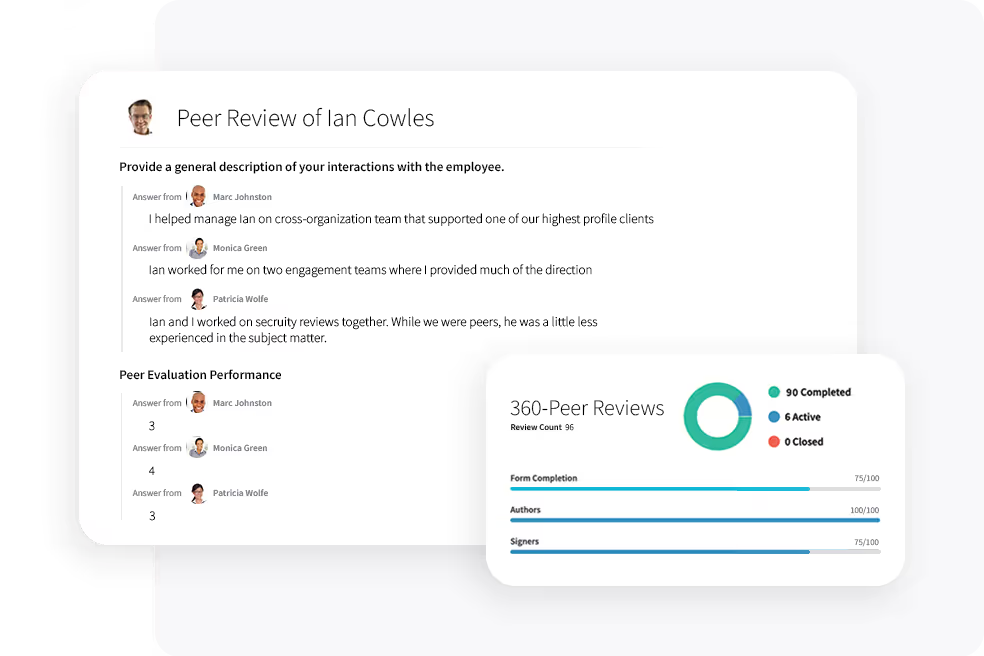55 Best Questions to Ask in Employee Performance Reviews
Performance reviews have long been considered a cornerstone of effective management. They play a crucial role in employees’ development, communication improvement, and workplace achievement. They provide a formal avenue for valuable feedback that can greatly improve a workspace.
However, despite the benefits of performance reviews, many employees often question their necessity. For a significant number of workers, performance reviews represent a bureaucratic process that feels detached from their daily work, causing anxiety and stress, and fostering a culture of competition rather than collaboration.
Performance reviews commonly cause problems with employees because managers are not asking the proper questions. They commonly ask closed-ended, leading, or judgy questions that do not highlight both an employee's values and needs for improvement.
This article should be used as a guide to equip employees and managers with questions that foster constructive, effective, and enlightening performance reviews. Using these questions should make performance reviews easier to complete and more constructive for the employee.
The list below consists of topics a performance review should center around. Additionally, using these topics should allow for more cohesive performance reviews:
- Employee Overall Performance
- Employee Strengths
- Employee Current Role & Responsibilities
- Possibility for Improvement
- Future Opportunities
- Relationship Between a Manager and His/Her Employees
- Peer Feedback
There are also two sections for employees to prepare for reviews and to utilize during a review, when responding to a manager. They include:
- Employee Self-Evaluation Questions
- Questions An Employee Should Ask a Manager
Finally, for managers considering how to handle reviews for certain employee milestones, such as 30-60-90 day reviews, we provide a list of questions that contextualize progress.
Questions Regarding an Employee’s Overall Performance
- "How would you evaluate your overall performance over the past year, considering your goals, projects, and responsibilities?"
- "What accomplishments from this review period are you most proud of and why?"
- "What challenges did you encounter in this review period and how did you overcome them?"
- "Looking back, is there any project or task you would approach differently? If so, how and why?"
- "In what ways can I make your job more enjoyable for you?"
Questions Regarding an Employee’s Strengths
- "Can you describe a project or situation where you felt you could utilize your strengths most effectively?"
- "What skills or strengths do you feel you bring to our team that are unique or particularly valuable?"
- "In which areas of your work do you feel most confident and why?"
- "Could you provide an example of a challenge you were able to overcome thanks to your strengths?"
- "What achievements or accomplishments are you most proud of this year, and how do your strengths contribute to them?"
Questions Regarding an Employee’s Current Role & Responsibilities
- "How well do you feel your current role aligns with your skills and interests?"
- "What aspects of your current role do you find most challenging and why?"
- “Do you feel comfortable with the requirements of your current role?”
- "What resources or support do you feel you need to perform your role more effectively?"
- "Could you share any ideas you might have for improving processes or efficiency within your current role?"
Questions Regarding Possibility for Improvement
- “What aspects of your role do you find most challenging, and did these challengers cause missteps for you this year?”
- "Are there specific skills or competencies you'd like to develop to enhance your performance in your current role?"
- "Are there any courses of action that we could take to better support you in your areas of struggle?"
- "Can you identify a recent project or situation where the outcome was not as expected? What would you do differently next time?"
- "What feedback have you received from colleagues or clients that could indicate areas for improvement?"
Questions Regarding Future Opportunities
- "What do you plan to accomplish for the next quarter?"
- "What are your long-term professional goals and how can we, as an organization, support you in achieving them?"
- "Are there specific skills or competencies you'd like to develop in the future to advance in your career?"
- "What opportunities or projects would you like to explore in the future that you believe could contribute to your professional growth?"
- "In terms of future roles or responsibilities, what changes or enhancements would motivate you to continue to excel within the organization?"
Questions Regarding the Relationship Between a Manager and His/Her Employees
- "How would you describe our communication? Is there anything we could do to improve it?"
- "Do you feel supported in your role? If not, what changes would you suggest?"
- "What expectations do you have of me as your manager that you feel are not being met?"
- "Do you prefer instant feedback on your work, or do you prefer a certain period before you have recognition of correct or incorrect execution?"
- "What can I do better as your manager to help you succeed in your role?"
A manager should also ask an employee’s peers about his or her performance. How an employee interacts with fellow employees is an essential part of running an office or organization effectively.
Questions for Peer Feedback
- "What strengths have you observed in this employee's work performance and how do they contribute to the team?"
- "Can you provide examples of projects or tasks where this employee has shown significant initiative or problem-solving skills?"
- "In your collaboration with this employee, have you noticed any areas where they might improve their work or teamwork skills?"
- "How does this employee handle feedback or criticism from peers? Can you provide specific instances?"
- "Could you share an example of how this employee has contributed to a positive work environment within the team?"
When leaving a performance review, an employee should always evaluate his or her accomplishments and shortcomings from the previous quarter or year. Therefore, it is important to ask self-evaluative questions that can put some of the struggles and successes into perspective.
Employee Self-Evaluation Questions
- "Have I truly understood the feedback given during the review and what steps do I need to take to address it effectively?"
- "What are the specific skills or competencies I need to develop or improve based on the feedback provided?"
- "How do the feedback and my performance align with my personal career goals and aspirations?"
- "How can I contribute more effectively to the team's success and the organization's objectives based on the feedback received?"
- "What proactive steps can I take to improve my performance before the next review, and how can I track my progress?"
Performance reviews should also be communicative. An employee should have some guidance from a manager in addition to his or her self-evaluation. If the manager is exclusively talking, there is a problem. The employee should feel comfortable with asking the manager some follow-up questions that can help set up improvements and goals for the next quarter. Some examples of helpful questions to ask your manager include:
Questions An Employee Should Ask a Manager
- "Could you provide specific suggestions for how I might improve in the areas we discussed?"
- "What training or professional development opportunities are available that could help me address the areas for improvement we identified?"
- "Can we discuss how my performance goals align with the overall objectives of the team or organization?"
- "In your view, what should be my top priorities moving forward to enhance my performance and contribute to the team more effectively?"
- "How can we ensure a better alignment between my skills and aspirations and the future opportunities within the team or organization?"
- "What steps can we take together to make sure the feedback provided today is incorporated into my daily work?"
- "Are there upcoming projects or roles where you believe I could make a significant contribution or that could be an opportunity for growth based on our discussion today?"
Questions That Contextualize Progress
Contextualizing performance reviews is critical. Understanding the specific circumstances and conditions under which an employee's performance occurs provides a more accurate and fair assessment. Whether you are planning for a new employee’s 30-60-90 day review or the ubiquitous annual review, it is important to look back on previous reviews and contextualize the progress that an employee has made.
Additionally, it is important to ask the employee how he or she was hindered in the period. It helps to separate the individual's skills and efforts from factors beyond their control, such as market conditions, internal changes, or unexpected events.
Some examples of questions that contextualize previous reviews are:
- “How well have you understood and met the responsibilities that have been added over this period?”
- “Over this period, which of your goals have you accomplished?”
- “Have there been any setbacks or challenges in this period that have hindered your success and timeliness in completing projects? Are there any ways I can help with these problems? How did you overcome these setbacks to the best of your ability?”
- “Have you set yourself up to comfortably complete large projects that come up in the future within their set deadlines?
- “Have you felt supported this past period? What can I do to support you further?”
- "Moving forward, what are your goals for the next period, and how can the management team support you in achieving these?"
- “Can you share an accomplishment or project from the past period that you believe demonstrates your growth in your role?"
- "What are your career development goals for the coming year, and how can we support you in achieving them?"
Additional Aspects to Consider
Maintaining organization is a crucial aspect of the performance review process. Giving questions and feedback to numerous employees can be difficult if the manager is not organized. An organized review process allows for a clearer understanding of each employee's performance. It can also ensure a fair, objective, and thorough assessment while providing employees with meaningful feedback that can guide their development and growth.
One of the best ways to keep performance reviews organized is by utilizing performance management software. This type of software offers a centralized platform where managers can track employee progress, record observations, and keep notes over time. It eliminates the need for paper-based systems, making the review process more efficient and environmentally friendly.

Performance management software can also provide a clear structure for performance reviews. If the questions that are asked are not structured effectively, they are not as useful. PerformYard can help make the review process more objective and transparent by using a structure that helps with monitoring goals, giving and receiving feedback, and evaluating performance based on predetermined criteria.


.jpg)

